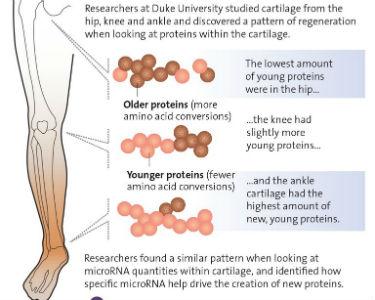
Exciting research from the Virginia Kraus lab, has identified a mechanism for innate cartilage repair in humans similar to that used by salamanders and zebrafish to regenerate limbs. They discovered a pattern of regeneration based on the location of cartilage – high level regeneration in the ankles, moderate level in the knee and low in the hips. This pattern of regenerative capacity is similar to limb repair in certain animals, which more readily regenerate at the furthest tips, such as the ends of legs or tails.
The researchers further learned that molecules called microRNA regulate this process. Not surprisingly, these microRNAs are more active in animals that are known for limb, fin or tail regeneration. Potentially as an evolutionary artifact, these microRNAs provide the capability for innate joint tissue repair in humans. Lead author Ming-Feng Hsueh, PhD, a researcher in the Kraus lab, called this capability our “inner salamander capacity.”
The goal is that this research may yield medicines to prevent, slow, or reverse arthritis. “We believe we could boost these regulators to fully regenerate degenerated cartilage of an arthritic joint. If we can figure out what regulators we are missing compared with salamanders, we might even be able to add the missing components back and develop a way someday to regenerate part or all of an injured human limb,” Kraus said. “We believe this is a fundamental mechanism of repair that could be applied to many tissues, not just cartilage.”
